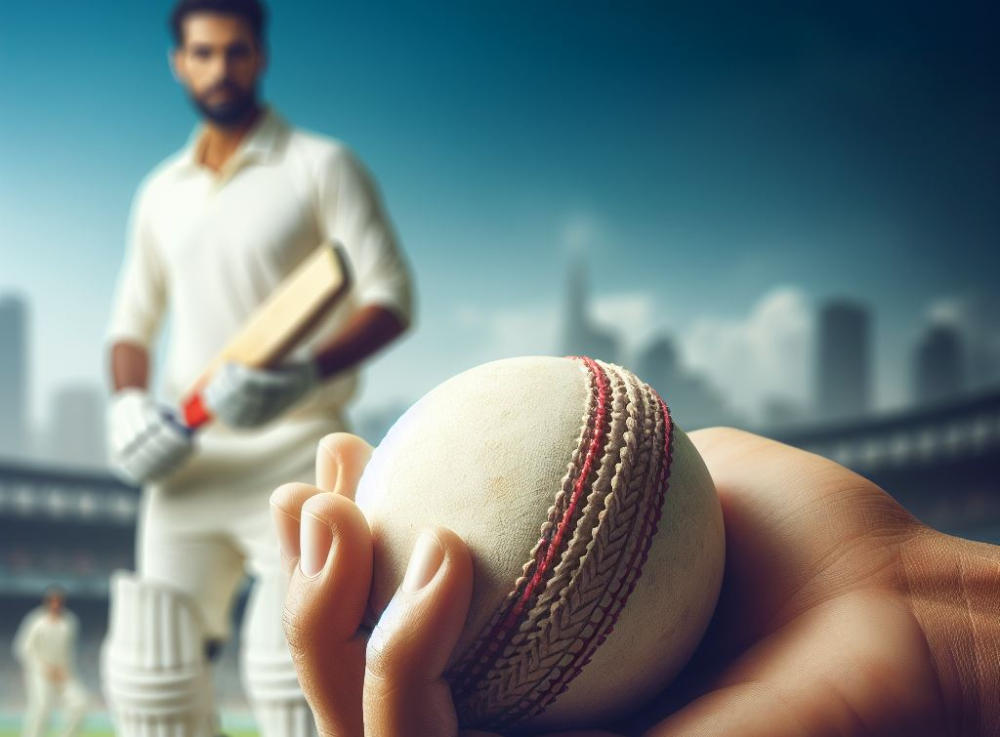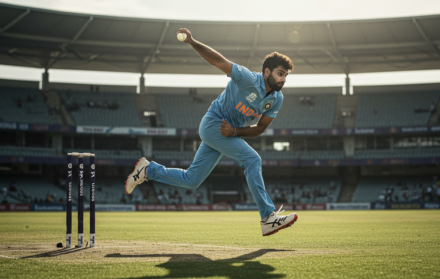
How To Master The Art Of Reverse Swing In Cricket
In the intricate world of cricket, mastering the art of reverse swing is akin to unlocking a secret realm of bowling prowess. This nuanced skill, cherished by fast bowlers, adds a dimension of unpredictability to the game, making it a potent weapon against even the most skilled batsmen.
Join us on a journey to delve into the nuances of reverse swing and discover how it can elevate your bowling strategy to new heights.
To truly master the art of reverse swing, one must understand the holistic approach to cricket, viewing it not just as a game but as a means of building confidence and self-esteem through cricket. Explore insights on how cricket serves as a transformative vehicle for personal growth and empowerment, fostering not only athletic prowess but also mental resilience and self-belief.
As you embark on the quest for reverse swing mastery, the choice of cricket gloves becomes paramount. Dive into considerations for optimal glove selection, unraveling the features that contribute to the perfect fit. Grip, comfort, and durability are the building blocks that ensure your hands are not just protected but optimized for delivering the elusive reverse swing.
Equally crucial in your arsenal is the selection of the right cricket bat size. Navigate through insights on dimensions, understanding how the right bat size plays a pivotal role in achieving optimal swing and control. A well-matched bat becomes an extension of your skill, enhancing your ability to execute the complexities of reverse swing.
Cricket, beyond its technicalities, is a team-building activity that fosters camaraderie and synergy. Uncover the role of cricket in promoting teamwork and collaboration, making it the perfect crucible for honing your reverse swing skills. Understand the collaborative spirit that makes cricket more than just a sport.
As you navigate the rules and scoring intricacies of cricket, immerse yourself in tips for overall game improvement. Gain actionable insights, elevating not only your reverse swing capabilities but also your overall performance on the cricket field.
In the pursuit of mastering reverse swing, the synergy of confidence, equipment, teamwork, and overall game improvement becomes the catalyst for success. Let these insights guide you on the path to becoming a maestro of reverse swing, transforming your bowling technique into an art form that keeps batsmen guessing and secures your place among the elite in the world of cricket.
Understanding the Basics of Swing Bowling in Cricket

Understanding the basics of swing bowling in cricket is crucial for any aspiring bowler. When attempting to achieve a successful swing, there are several key points to take into account. One important factor is grip, as holding the ball with an angled seam will result in asymmetrical airflow around it.
Another vital aspect is seam position; the shiny side of the ball should be kept on the desired swinging side. Additionally, it is essential to focus on releasing the ball with a relaxed wrist and a smooth follow-through motion.
Moreover, it is worth noting that swing is more noticeable in damp and overcast conditions.
Finally, to master the art of swing bowling in cricket, regular practice and experimentation with different angles and techniques are necessary.
What is Swing Bowling?
Swing bowling is a crucial technique in the game of cricket that involves manipulating the ball’s flight path in the direction towards or away from the batsman. It is accomplished by applying lateral rotation to the ball while it is in the air.
Traditional swing bowling relies on the process of shining one side of the ball to create a difference in airflow, ultimately resulting in the ball swinging. In contrast, reverse swing bowling occurs when the ball swings in the opposite direction due to the wear and tear on one side, coupled with a dry pitch.
To outsmart batsmen, it is imperative for bowlers to grasp the mechanics and variations of swing bowling.
How Does Reverse Swing Differ from Conventional Swing?
Reverse swing differs from conventional swing in several ways.
- Direction: Conventional swing moves in the same direction as the shiny side of the ball, while reverse swing moves in the opposite direction.
- Ball condition: Conventional swing relies on a new ball, while reverse swing occurs with an old or rough ball.
- Seam position: In conventional swing, the shiny side of the ball faces the batsman, while in reverse swing, the rough side faces the batsman.
- Ball movement: Conventional swing relies on air pressure and the ball’s seam to generate movement, while reverse swing is aided by roughness on one side of the ball, causing it to deviate in the air.
- Skill requirement: Reverse swing requires more skill and practice to execute effectively due to its dependence on specific ball conditions and techniques.
The Science Behind Reverse Swing

Unlocking the secrets of reverse swing in cricket, we delve into the fascinating realm of the science behind this game-changing technique. Explore the factors that influence reverse swing and the crucial role ball maintenance and condition play in its execution.
Get ready to uncover the intriguing dynamics and physics that make reverse swing a formidable weapon in a bowler’s arsenal. Let’s embark on this journey and unravel the science behind this enigmatic art.
Factors Affecting Reverse Swing
- The shine on one side of the ball plays a crucial role in creating reverse swing. Applying sweat or saliva on the shiny side helps maintain swing for longer.
- The condition and positioning of the seam affect the airflow and turbulence around the ball, influencing reverse swing. A well-maintained and upright seam aids in generating reverse swing.
- The condition of the outfield and the grass on the pitch can impact reverse swing. A dry and abrasive outfield can scuff up the ball, making it easier to swing.
- Humidity, temperature, and wind speed impact reverse swing. Dry and hot conditions favor reverse swing, as the ball quickly loses moisture and becomes rough.
- The speed at which the bowler delivers the ball affects reverse swing. Moderate to fast bowling speeds allow the ball to generate enough airflow and swing in the later stages of its trajectory.
Role of Ball Maintenance and Condition
Proper ball maintenance and condition play a significant role in achieving effective reverse swing in cricket. The role of ball maintenance and condition cannot be overstated when it comes to optimizing swing potential. Here is a step-by-step guide to ensure the ball performs optimally:
- Polishing: One essential step is to maintain a smooth surface on one side of the ball. This helps create differential airflow, which is crucial for facilitating swing.
- Shining: Regularly shining the ball with sweat, saliva, or approved shining agents is another vital aspect. This process enhances the ball’s swing potential and increases its effectiveness.
- Keeping the Seam Intact: To maximize swing movement, it is imperative to preserve the shape and position of the ball’s seam. This plays a crucial role in achieving optimal swing.
- Protecting the Ball: Keeping the ball dry is crucial to prevent excessive wear and tear, which can significantly reduce the swing’s effectiveness. Proper protection ensures the ball maintains its condition and performs optimally.
- Monitoring Field Conditions: It is essential to assess the outfield and pitch conditions thoroughly. Understanding how these conditions will affect the ball’s behavior is crucial in strategizing and making decisions during the game.
By diligently following these steps and consistently monitoring the ball’s condition, players can optimize reverse swing and gain a competitive advantage. The role of ball maintenance and condition in achieving outstanding swing cannot be emphasized enough.
Mastering the Techniques of Reverse Swing
Want to take your cricket skills to the next level? In this section, we’ll unlock the secrets of mastering the art of reverse swing. Get ready to dive into the techniques that will give you the upper hand on the cricket pitch.
From perfecting the grip and seam position to refining your bowling techniques, we’ll cover everything you need to know.
Plus, we’ll explore a range of bowling variations that will take your reverse swing game to new heights. Get ready to become a force to be reckoned with on the cricket field!
Grip and Seam Position
Using the correct grip and seam position is crucial for executing effective reverse swing in cricket. Grip is the first key point to consider.
Hold the ball with the shiny side down and the seam between the index and middle fingers.
Seam Position, the second point, requires tilting the seam slightly towards the leg side to create asymmetry and enhance the chances of reverse swing.
Lastly, the Angle of Release needs to be taken into account. Bowl with a slightly angled wrist towards the leg side to maintain the desired seam position.
In the 2010 Ashes series between England and Australia, James Anderson’s exceptional grip and seam position played a vital role in his reverse swing mastery. His ability to consistently generate movement troubled the Australian batsmen, leading to England’s victory in the series.
Bowling Techniques for Reverse Swing
To master the bowling techniques for reverse swing in cricket, follow these steps:
-
- Get the grip and seam position right. Hold the ball with the shiny side facing the leg side and the seam angled towards first slip.
- Focus on wrist position and release. Tilt your wrist slightly towards the leg side and use a sidearm release to impart swing.
- Vary your pace and length. Bowl slower with a fuller length to give the ball more time to swing.
- Work on subtle changes in seam position. Adjust the angle of the seam to control the direction and amount of swing.
- Practice control and consistency. Use a target and repetitively bowl in that area to hone your accuracy.
By following these bowling techniques for reverse swing, you can become adept at utilizing this challenging skill in cricket.
Bowling Variations to Enhance Reverse Swing
To enhance reverse swing in cricket, bowlers can employ various bowling variations, which have proven effective over time. These techniques not only add excitement to the game but also make it harder for the batsman to anticipate the movement of the ball.
One such variation is the “change of pace.“ By altering the speed of the delivery, bowlers can deceive the batsman and disrupt their timing. This change in pace can be a crucial factor in inducing reverse swing, as it adds an element of surprise to the delivery.
Another useful technique is the “cross-seam delivery.“ Instead of gripping the ball along the seam, bowlers grip it across the seam. This disrupts the airflow over the ball and creates an imbalance, leading to reverse swing.
Furthermore, the “leg-cutter“ is a delivery that moves away from the batsman. This is achieved by using the seam position in conjunction with wrist movement. The combination of these factors creates the desired movement and enhances the chances of reverse swing.
On the other hand, the “off-cutter“ employs similar techniques as the leg-cutter but in the opposite direction. This variation moves towards the batsman, creating confusion and making it even more challenging for the batsman to read the delivery.
These bowling variations have been perfected by some of the greatest exponents of reverse swing, like Wasim Akram. He is credited with revolutionizing the art of seam position and wrist position variations to enhance his reverse swing bowling.
Bowlers can rely on a variety of bowling variations to enhance reverse swing in cricket. These techniques, such as change of pace, cross-seam delivery, leg-cutter, and off-cutter, can bring excitement and unpredictability to the game.
Developing the Skills Required for Effective Reverse Swing

Developing the skills required for effective reverse swing in cricket involves focusing on physical fitness and strength, coupled with dedicated practice and repetition.
Mastering the art of reverse swing requires a combination of athleticism and technique that can make all the difference on the field.
Understanding the importance of these sub-sections will provide valuable insights into how aspiring cricketers can enhance their abilities in this specialized bowling technique.
Get ready to unlock the secrets of reverse swing and take your game to new heights.
Physical Fitness and Strength
Having the right physical fitness and strength is crucial for mastering the art of reverse swing in cricket.
Players need to focus on building overall endurance and strength in order to generate the necessary power and control while bowling.
Strength training exercises, such as squats, lunges, and core workouts, can help develop the required muscle power.
Incorporating cardiovascular exercises, like running and interval training, is important for maintaining stamina on the field.
Practice and Repetition
To become a master of the art of reverse swing in cricket, practice and repetition are of utmost importance. It entails following these steps:
- Comprehend the technique: Familiarize yourself with the proper grip and seam position required for executing reverse swing.
- Deliver with intent: Engage in practicing various bowling techniques specifically designed to achieve the desired reverse swing.
- Diversify your deliveries: Experiment with different bowling variations to enhance control and boost effectiveness.
- Hone your skills: Focus on improving your physical fitness and strength to ensure you possess the stamina and power necessary for effective reverse swing.
- Consistent practice: Allocate sufficient time to regularly practice reverse swing, repeating the techniques until they become second nature.
By consistently dedicating yourself to practice and diligently repeating these steps, you will witness a noticeable improvement in your reverse swing skills. Consequently, you will become a valuable asset to your cricket team.
Tips and Strategies for Using Reverse Swing in Matches
Unlock the secrets of reverse swing in cricket with these valuable tips and strategies for using this deceptive bowling technique effectively in matches.
We’ll explore how to read the conditions and pitch to maximize the potential of reverse swing. Learn how effective communication and collaboration with the captain and fielding team can make a difference on the field.
Discover the psychological factors that come into play when executing reverse swing and gain an edge over the opposition.
Reading the Conditions and Pitch in Cricket
In mastering the art of reverse swing in cricket, it is crucial to carefully read and understand the conditions and pitch. The conditions encompass various factors such as weather, temperature, and humidity, while the pitch refers to the state of the playing surface.
By thoroughly assessing these elements, bowlers are able to gauge the potential for achieving reverse swing.
When considering the conditions and pitch, several key factors come into play. Dry and abrasive pitches have the tendency to scuff and roughen the ball, which can greatly influence its movement. Likewise, humid conditions can facilitate ball movement in different ways.
With a comprehensive understanding of these aspects, bowlers can adapt their strategies accordingly, increasing their chances of achieving effective reverse swing.
An intriguing piece of cricketing history is the origins of reverse swing, which can be traced back to Pakistani bowlers during the 1970s.
Legendary figures like Imran Khan and Sarfaraz Nawaz were instrumental in developing and perfecting this technique.
As a result, they revolutionized the art of swing bowling and left an enduring impact on the game.
Communicating and Collaborating with the Captain and Fielding Team
To effectively utilize reverse swing in cricket, communicating and collaborating with the captain and fielding team are crucial.
- Relaying information: Share observations about pitch conditions, the condition of the ball, and any patterns noticed with the captain and team.
- Strategic discussions: Discuss potential variations in bowling and fielding tactics to optimize the impact of reverse swing.
- Fielding placement: Collaborate with the captain to position fielders strategically to capitalize on the movement of the ball.
- Adjustments: Communicate with the captain and fielders to make adjustments in real-time based on the behavior of the ball and the batsmen.
Effective communication and collaboration can enhance the team’s success in utilizing reverse swing as a key weapon in cricket matches.
Psychological Factors in Reverse Swing
Understanding the psychological factors involved in reverse swing is crucial for success in cricket. The amalgamation of psychological factors and reverse swing is key.
Confidence plays a significant role, as bowlers need to believe in their abilities and strategies. They must also remain composed under pressure, staying focused and disciplined.
Effective communication with the captain and fielding team is essential, ensuring everyone is on the same page and working towards a common goal.
The understanding of the batsmen’s mindset can greatly assist bowlers in making strategic decisions and outsmarting their opponents.
Being mentally strong and resilient is paramount to harnessing the psychological factors that contribute to successful reverse swing.
In a historical context, one notable example of the psychological factors in reverse swing occurred during the 2005 Ashes series between England and Australia.
The understanding of psychological factors played a vital role. English bowler Andrew Flintoff’s confidence and assertiveness on the field, combined with his ability to consistently deliver reverse swing, proved instrumental in England’s victory.
His psychological dominance over the Australian batsmen played a significant role in England reclaiming the Ashes after a 16-year drought.
Common Challenges and Troubleshooting in Reverse Swing

Mastering the art of reverse swing in cricket comes with its fair share of challenges and troubleshooting. In this section, we’ll tackle these obstacles head-on.
Whether it’s dealing with unresponsive conditions, managing the wear and tear of the ball, or overcoming technical issues, we’ll provide you with the insights and strategies you need to enhance your reverse swing skills.
Get ready to conquer the difficulties that arise when attempting this deceptive and game-changing technique.
Dealing with Unresponsive Conditions
- When faced with unresponsive conditions in cricket, players can employ certain techniques to deal with unresponsive conditions and still achieve reverse swing. Here’s a list of steps to deal with unresponsive conditions:
- Choose a well-maintained ball to maximize the chances of swing.
- Focus on bowling with precision and accuracy, hitting the right areas consistently.
- Experiment with different angles and release points to try and generate movement off the pitch.
- Alter the field placements strategically to capitalize on any slight movement or deviation.
- Communicate and collaborate with the captain and fielding team to adjust tactics and make necessary changes.
Fact: Despite dealing with unresponsive conditions, skilled bowlers can still generate reverse swing by mastering the art of maintaining the ball and employing strategic tactics.
Managing the Wear and Tear of the Ball
- Rotate the ball regularly to distribute wear evenly.
- Keep the ball dry to prevent excessive damage.
- Avoid bouncing the ball on rough surfaces.
- Keep the ball clean by wiping it with a dry cloth regularly.
- Inspect the ball regularly for any signs of damage or wear.
- Use appropriate ball maintenance techniques, such as shining one side and roughing up the other.
- Store the ball in a cool, dry place when not in use.
To effectively manage the wear and tear of the ball, follow these practices to ensure its condition remains optimal throughout the game. By incorporating these techniques, bowlers can maintain the ball’s effectiveness for achieving reverse swing.
Overcoming Technical Issues
- Identify the specific technical issue you are facing with your reverse swing.
- Analyze the root cause of the issue to overcome technical issues, whether it’s related to grip, seam position, or body alignment.
- Consult with experienced coaches or bowlers to gain insights and suggestions for overcoming the technical issue of reverse swing.
- Focus on proper grip and seam position during practice sessions to improve control and consistency when overcoming technical issues.
- Experiment with different bowling techniques and variations to find what works best for you when overcoming technical issues.
- Pay attention to your body mechanics and ensure proper alignment and balance throughout your delivery to overcome technical issues.
- Review your performances and practice videos to identify any patterns or common mistakes that may be contributing to the technical issue of reverse swing and overcoming them.
- Implement targeted drills and exercises to specifically address the technical issue and improve your skills when overcoming technical issues.
- Consistently practice and repeat the correct techniques to reinforce muscle memory and overcome the technical issues of reverse swing.
- Stay patient and persistent, as overcoming technical issues in reverse swing may take time and dedication.
Additional Resources for Improving Reverse Swing Skills
To improve your reverse swing skills, it’s important to utilize additional resources for improving reverse swing skills that can provide valuable insights and techniques. Here are some additional resources for improving reverse swing skills that can help:
- Video tutorials: Online platforms like YouTube offer a wide range of videos demonstrating reverse swing techniques and drills.
- Coaching clinics: Attend specialized cricket coaching clinics where experienced coaches can provide personalized guidance and feedback.
- Books and eBooks: Explore cricket literature that delves into the nuances of reverse swing and offers expert advice.
- Online forums and communities: Engage with fellow cricketers on online forums to discuss and learn from their experiences and insights.
Pro-tip: Consistent practice, dedication, and seeking expert guidance from these additional resources for improving reverse swing skills are key to mastering the art of reverse swing in cricket.
Frequently Asked Questions
How do I polish the cricket ball while keeping it legal?
According to the article by Rishabh Mehan and Hunter Rising, you can polish the cricket ball by wetting your hands with sweat or saliva from your body. Licking your fingers occasionally can also add moisture. It is important to note that using any foreign substance, including sunscreen, is illegal and can result in fines or bans from the match.
When should I start bowling for a reverse swing?
The article suggests that you should start bowling for a reverse swing after the ball has gone through 25-30 overs. During this time, continue to polish one side of the ball while leaving the other side to develop wear and tear.
How should I hold the cricket ball for a reverse swing?
To bowl a reverse swing, hold the ball with the seams pointing toward the slips fielder, lining the stitches up towards the first slip. Point the rough side of the ball toward the batsman, while the shiny side faces in the opposite direction. This positioning is crucial for achieving the desired reverse swing effect.
What angle should I maintain my wrist at while bowling for a reverse swing?
Keep your wrist at a 20-30-degree angle to the ground to maintain a consistent bowling style for a reverse swing. This angle will help you achieve the desired movement and control of the ball.
What is the science behind reverse swing in cricket?
The article explains that reverse swing occurs because air flows quicker over the rough side of the ball, creating suction on the smooth side. This uneven airflow causes the ball to move in the opposite direction than what the batsman expects, making it difficult to play. Understanding this science can help you master the art of reverse swing.
How can I avoid giving away that I’m trying the reverse swing technique?
The article advises against changing your bowling style while attempting the reverse swing. By maintaining your usual bowling style, you can avoid giving any hints to the batsman that you are using this technique, increasing your chances of success.





